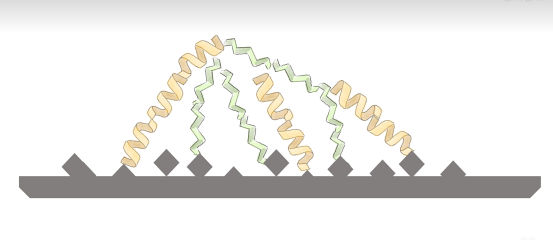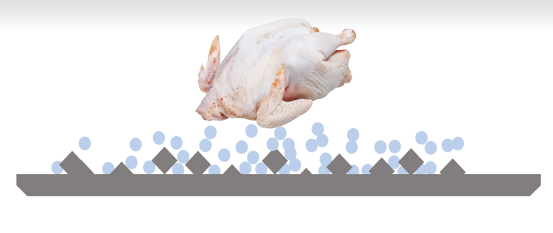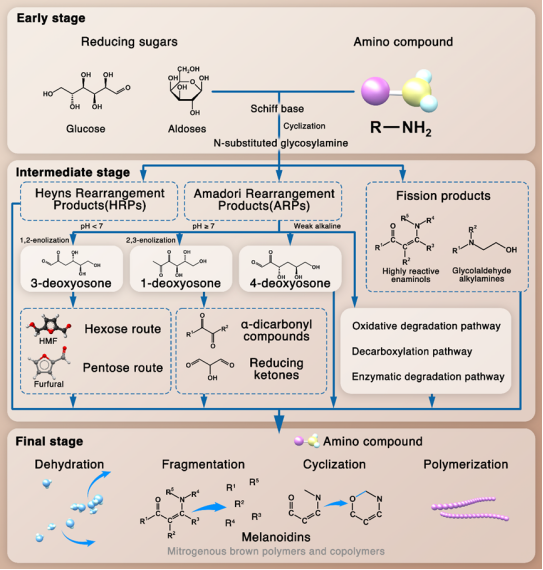فهم سبب التصاق الطعام بالمقالي
من المشاكل الشائعة هي التصاق الطعام بأواني الطهي، ولكن قبل أن نتمكن من حل هذه المشكلة، دعونا نلقي نظرة فاحصة على السبب الجذري لها. عندما يتعلّق الأمر بالمطبخ، عادةً ما تنقسم الحالات اللزجة إلى فئتين رئيسيتين من المواد الغذائية.
1- الأزهار الجيدة: البروتينات الدسمة الموجودة في اللحم والطيور وفي أكياس البروتين.
2- الأحماض الأمينية الحرة والسكريات الحرة والمرتبطة والنشويات: توجد في المقام الأول في سائل طهي المواد الغذائية.
تتفاعل هذه المواد مع سطح المقلاة بحيث تشجع على الالتصاق. دعونا نستكشف كيف.
1. عامل البروتين في المناظر الطبيعية، التفاعلات الكيميائية
تتغيّر طبيعة البروتينات في وجود المعدن، ولهذا السبب عندما تقوم بتسخين الأطعمة الغنية بالبروتين مثل اللحوم والبيض في مقلاة معدنية، فإنها تلتصق بها. وتفتح هذه العملية تدريجيًا هياكلها المعقدة ثلاثية الأبعاد، كاشفة عن سلاسل جانبية تفاعلية ومجموعات أمينية. هذه المجموعات البوليسترية ومجموعة الكربوكسيل الحرة، مما يسمح لها بالتفاعل مع ذرات المعادن (الحديد موجود هنا بشكل خاص) على سطح المقلاة.

إن سطح المقالي المصنوعة من الفولاذ المقاوم للصدأ أقل تفاعلاً من سطح الحديد النقي، ولكن لا تزال هناك ذرات معدنية متاحة للتفاعل مع البروتينات المشوهة. هذا الترابط الكيميائي هو ما نسميه الآن "التصاق" الطعام بالمقلاة، وهو ما يعادل الالتصاق.
2. دخول السوائل: شقوق المقلاة بمثابة مسامات قرصية
يتحلل الطعام أثناء طهيه ويطلق سوائل تحتوي على الأحماض الأمينية والسكريات والنشويات. هذا حتى تتمكن هذه السوائل من إيجاد طريقها إلى تلك الزوايا المجهرية والجرانيت وتعلق في أي شقوق أو مسام قد تكون موجودة على سطح المقلاة. عند تسخين المقلاة، يحدث عدد من الأشياء:

تفاعل مايارد: تكون المركبات بنية اللون وتتكون من الأحماض الأمينية والسكريات، وتحدث التغيرات من خلال التحمير غير الإنزيمي في درجات الحرارة العالية. يمكن أن تنحصر هذه البوليمرات في عيوب سطح المقلاة مما يؤدي إلى الالتصاق.

جلتنة النشا: تمتص النشويات الماء وتنتفخ وتبدأ في الالتصاق بالسطح.
تحدث هذه العمليات في وقت واحد. في حين أن أواني الطهي غير القابلة للصدأ يمكن أن تكون غير لاصقة، إلا أنه يجب التعامل مع هذه العوامل بشكل شامل.
خطوتان لتجنب التعثر الجزء الأول - لا تتعثر
1- تثبيط البروتين الملزم لسطح المقلاة
تقليل الاتصال المباشر: استخدم حاجزًا بين الطعام والسطح المعدني.مكونات مطبوخة مسبقاً: على سبيل المثال، يمكن أن يؤدي استخدام شرائح السمك المطبوخة مسبقًا، حيث تم تغيير طبيعة البروتينات إلى تسهيل الالتصاق.
مكونات مطبوخة مسبقاً: على سبيل المثال، يمكن أن يؤدي استخدام شرائح السمك المطبوخة مسبقًا، حيث تم تغيير طبيعة البروتينات إلى تسهيل الالتصاق.
2- المعالجة السطحية
على الرغم من أنه لا يمكن تتبيل الفولاذ المقاوم للصدأ مثل الكربون أو الحديد الزهر، إلا أن الحفاظ على سطح نظيف وناعم يمكن أن يقلل من الالتصاق بشكل كبير.
عامل الزيت - أكثر من مجرد التشحيم
لماذا الزيت البارد على وعاء بارد غير فعال؟
يمكن أن يؤدي البدء بزيت بارد في مقلاة باردة إلى توزيع غير متساوٍ للحرارة، مما يزيد من فرصة الالتصاق. عند تسخين الزيت، يصبح الزيت أقل لزوجة ويمكنه تغطية سطح المقلاة بشكل أفضل.
أفضل درجة حرارة الطهي: حوالي 200 درجة مئوية (392 درجة فهرنهايت) مثالية لمعظم زيوت الطهي، مما يضمن اللزوجة والتوتر السطحي المناسبين.
نقطة الدخان: تجنب تجاوز حوالي 250 درجة مئوية (482 درجة فهرنهايت)، حيث يمكن أن يتسبب ذلك في تدهور الزيت وإطلاق مركبات ضارة.
تأثير مارانجوني
عند تسخين الزيت، قد تبدأ برؤية تموجات أو خطوط على السطح. يؤدي تسخين مركز قطرة الزيت إلى تسخين سطحها في جميع أنحاء جسمها، وهو ما يُستخدم كمقياس لتحديد متى وصل الزيت إلى درجة الحرارة المثالية للطهي.
هناك خرافة شائعة مفادها أنه يجب البدء بمقلاة ساخنة وزيت بارد عند القلي. قد تكون هذه العملية فعالة مع المقالي الحديدية الكلاسيكية بسبب الأكسدة السريعة لسطح المقلاة، ولكنها ليست فعالة مع أواني الطهي المصنوعة من الفولاذ المقاوم للصدأ. يمكن أن تؤدي إضافة الزيت البارد إلى مقلاة ساخنة إلى توزيع غير متساوٍ للحرارة والتسبب في الالتصاق.
تأثير لايدنفروست: ليس حلاً للطبخ اليومي
يحدث تأثير لايدنفروست عندما ترتد قطرات الماء على سطح ساخن بسبب البخار. في حين أنه قد يمنع الالتصاق على المدى القصير عن طريق إبعاد الطعام عن المقلاة، إلا أنه لا يعمل في الطهي اليومي:
- كثافة مصدر الحرارة: يجب أن تكون المقلاة ساخنة بشكل خطير، مما يؤدي إلى خطر الإصابة بالحروق.
- مشكلات الملمس: لا يحول الطعام إلى مزيج سلس.
- التحكم في درجة الحرارة: قد يكون من الصعب الحفاظ على درجات حرارة عالية بما يكفي لفترات طويلة.
- مخاطر السلامة: تزيد المقالي الساخنة من خطر الإصابة بالحروق وحوادث المطبخ.
نصيحة مباشرة حول الطهي بدون التصاق في أواني الفولاذ المقاوم للصدأ
1.سخن المقلاة بشكل صحيح: ابدأ على حرارة متوسطة للتسخين المنتظم. تُرشّ بضع قطرات من الماء في المقلاة؛ إذا كانت تصدر أزيزاً وتتبخر بسرعة، فهذا يعني أن المقلاة ساخنة.
2.أضف الكمية المناسبة من الزيت: يُسخّن حوالي 1/4 بوصة من الزيت حتى يتلألأ (لا يدخن) قبل إضافة الطعام.
3.مراقبة سلوك الزيت: راقب التموجات أو الأنماط في الزيت، مما يشير إلى وصوله إلى درجة الحرارة المناسبة.
4.الحفاظ على درجة حرارة الطهي المناسبة: أبقِ الزيت أقل من درجة دخانه واضبطي الحرارة حسب الضرورة.
5- التحلي بالصبر: اتركي البروتينات حتى تنضج قبل تقليب الطعام أو تحريكه. تجنبي استخدام الأواني المعدنية لمنع الخدش.
فهم سطح المقلاة وصيانتها
نعومة السطح: تعتبر المقالي المصنوعة من الفولاذ المقاوم للصدأ أكثر سلاسة من الحديد الزهر أو الفولاذ الكربوني، مما يقلل من احتمالية التصاق الطعام.
التنظيف والعناية: نظّفي المقلاة جيدًا بعد كل استخدام لمنع تراكم البقايا التي قد تؤدي إلى الالتصاق.
توابل الفولاذ المقاوم للصدأ؟
على الرغم من أن الفولاذ المقاوم للصدأ يفتقر إلى خصائص التتبيل التي يتمتع بها الحديد الزهر، إلا أن بعض الطهاة يقترحون تسخين الزيت في مقلاة من الفولاذ المقاوم للصدأ لتكوين قشرة رقيقة مبلمرة يمكنها تحسين خصائص عدم الالتصاق مؤقتًا. ومع ذلك، فإن هذا أقل متانة بكثير من التتبيل التقليدي.
هل تستحق المقالي المصنوعة من الفولاذ المقاوم للصدأ العناء؟
على الرغم من مشاكل الالتصاق، إلا أن المقالي المصنوعة من الفولاذ المقاوم للصدأ توفر العديد من المزايا:
- المتانة: مقاومة للصدأ والتآكل والتشقق.
- تعدد الاستخدامات: مناسب لطرق الطهي المختلفة، بما في ذلك التحمير والقلي.
- توزيع متساوٍ للحرارة: خاصة في الإنشاءات متعددة الطبقات.
حلول مخصصة لأواني الطهي المصنوعة من الفولاذ المقاوم للصدأ
كما واحدة من أفضل الشركات المصنعة لأواني الطهي المصنوعة من الفولاذ المقاوم للصدأ حسب الطلبفنحن نعرف تماماً كيفية تصميم المنتجات وتحسينها. نحن نقدم حلولاً مثل أغطية الموقد، والأواني المصممة بأقل قدر من الالتصاق، وأدوات الطهي المخصصة بناءً على احتياجاتك وتفضيلاتك.
- المعالجات السطحية المتقدمة: تعزيز النعومة وتقليل التفاعلية.
- تصميم متعدد الطبقات: يزيد من أداء التدفئة والاحتفاظ بالحرارة إلى أقصى حد.
الخاتمة
إن المقالي المصنوعة من الفولاذ المقاوم للصدأ التي تلتصق ليست قدراً يجب أن نقبله. والخبر السار هو أنه من خلال فهم العلم الكامن وراء الطهي، يمكنك الحصول على أداء طبيعي غير لاصق دون اللجوء إلى الطلاءات الاصطناعية.
- سخن المقلاة والزيت على درجة الحرارة المناسبة
- التحكم في درجة الحرارة
- استخدام الزيت بشكل صحيح
- دع الزيت يغطي المقلاة بالكامل
من خلال اتباع هذه الإرشادات، يمكنك زيادة فوائد أواني الطهي المصنوعة من الفولاذ المقاوم للصدأ في المطابخ المنزلية والمهنية على حد سواء.
